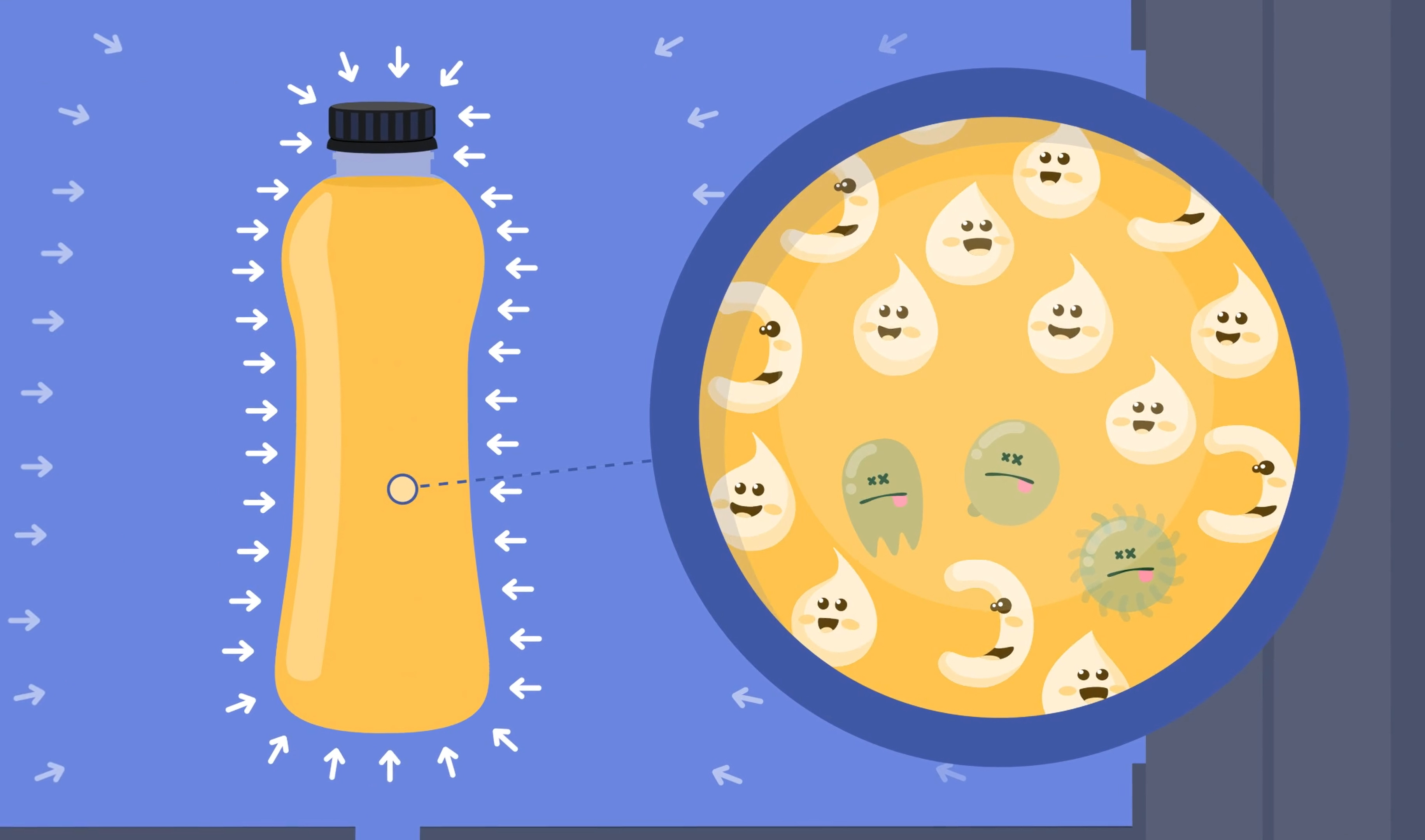
How high pressure affects food safety and shelf life
High pressure processing can be used to inactivate a variety of microorganisms and thus extend the shelf life of food products.
High pressure processing of food has been used commercially since the 1990s. HPP can be used as a pasteurisation method. In 2004, the technology was recognised by the U.S. Food and Drug Administration (FDA) as a process that provides 5-log reduction in the relevant pathogenic bacteria in products such as fruit juices.
Increased food safety and extended shelf life are the main reasons for using HPP on food. Different microorganisms, both pathogenic and degrading bacteria, are affected differently by high pressure. In general, spores can be said to be the microorganisms that best tolerate HPP, and parasites are those most easily inactivated.
The extent to which microorganisms are inactivated in HPP depends on a number of parameters such as the type of microorganism, pressure, time, temperature, pH, water content and food composition. Increased inactivation is generally achieved with increasing pressure.
Sometimes it may be necessary to combine high pressure with one or more factors that can produce a combination effect to achieve the desired inactivation and/or shelf life of the food product in question. Such additional factors may include low pH, salt, sugar, increased temperature during processing or antimicrobial components.
Factors affecting bacterial inactivation with use of HPP
Inactivation of microorganisms using HPP is affected by several factors:
1. Processing parameters
The pressure used, processing time and processing temperature are the main variable parameters in HPP.
More details on how high pressure can be used for various purposes.
If the main objective is to inactivate pathogenic bacteria, a pressure above 400 MPa is often necessary to use. Commercial HPP equipment can often be used for pressure of up to 600 MPa. Processing at, for example, 600 MPa for 2-5 min. will result in a significant inactivation of most bacteria. How well HPP works in ensuring the food safety of a product depends on the initial number of bacteria and bacteria type. As previously mentioned, this technology can give a 5-log reduction.
Storage time following processing affects the shelf life of the product. If the food products are stored below 4°C, many bacteria will not grow at these temperatures. Listeria is an example of a bacterium that can grow at refrigerator temperatures, and attention therefore needs to be paid to this when working with products where Listeria may be a challenge.
Another relevant parameter is temperature during processing. Commercial HPP equipment usually does not offer the possibility of temperature control. The HPP equipment is usually kept at room temperature, or placed in a cool room. Most HPP products are often refrigerated products. If the equipment is placed in a cold store room, the advantage is that the temperature fluctuations to which the products are exposed are kept to a minimum.
There is currently no HPP equipment that allows HPP to be combined with increased temperature for commercial production of food products. This type of equipment is only available in laboratory models. In the long term, when this type of equipment becomes available for commercial use, this technology can be used to achieve sterilisation conditions. This will contribute to the technology also being useable for inactivation of spores.
More details on spore problems
2. Microbial properties
Different types of microorganisms are affected by pressure to varying degrees. A number of microbial properties are important, but the most important issue is what type of bacterium is involved. It is, for example, well known that the structure of a microorganism affects its ability to withstand pressure. In general, Gram-negative bacteria are more sensitive to high pressure than Gram-positive bacteria. This is connected with the structure of the cell membrane. In addition, it is known that bacteria that are in a growth phase are more sensitive than bacteria in a stationary phase.
HPP works well for inactivation of vegetative (growing) bacteria. Some bacteria such as Bacillus and Clostridium may enter an alternate life cycle where they form spores in addition to a vegetative phase in which they undergo regular growth and cell divisions. Bacterial spores are highly resistant, and once the bacteria have entered this hibernation phase, they can be very difficult to inactivate. Despite processing at extreme pressures, spores can survive pressures above 600 MPa, even at long holding times. HPP often has to be combined with heat to inactivate spores.
3. Properties of the processing medium
The type of processing medium used greatly affects what effect pressure has on inactivation of microorganisms. If the objective is to kill bacteria, it is of great importance in many cases if the bacteria occur in a solid or liquid food product.
When researchers study the survival of bacteria in the laboratory, the bacteria are often added to a liquid broth medium and exposed to high pressure. In general, the bacteria are then seen to have a higher survival rate in foods exposed to high pressure than they do in growth media that are most often used in the laboratory. The composition of the food product, such as the amount of water, fat, salt, sugar and low/high pH, affects how sensitive microorganisms are to HPP. Low water activity has also been shown to produce increased microbial resistance.
Unlike in heat treatment, where the size and geometry of the food products are of importance, this generally does not apply to HPP. In fact, the pressure load in HPP occurs immediately throughout the product regardless of size and geometry. This is beneficial to, for example, upscaling processes.
Different types of bacteria withstand pressure differently and have different survival rates in food. One example is that the importance of pH depends on the type of microorganism that is being studied. As the type of food product has such a major effect on the quantity of microorganisms that are inactivated, it will be important for a food producer to perform tests with the producer’s own products, as, for example, product formulas may have an impact on how effective HPP can be.
